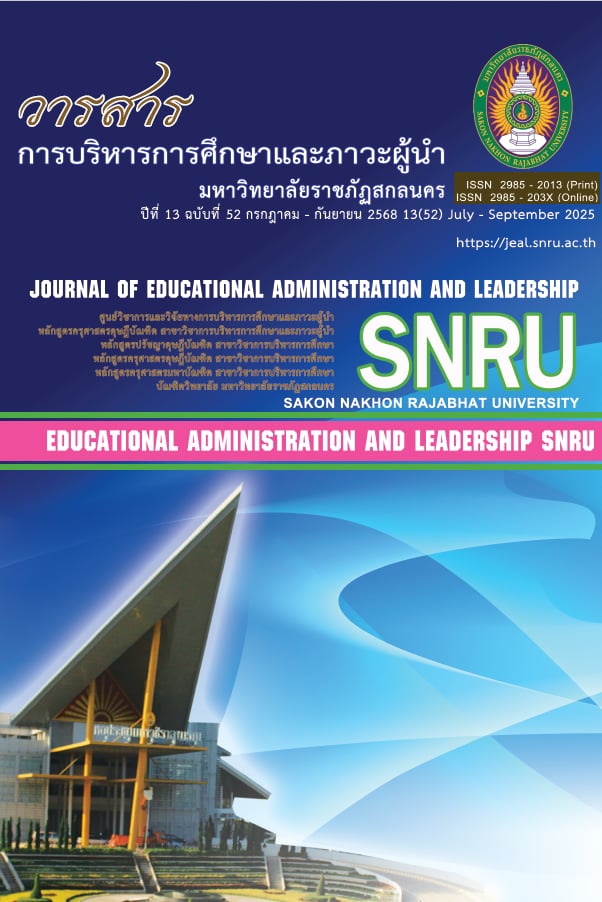

แนวทางการพัฒนาเครือข่ายความร่วมมือของโรงเรียนขนาดเล็ก สังกัดสำนักงานเขตพื้นที่การศึกษาประถมศึกษาสุรินทร์ เขต 1
The Guidelines for Developing Collaboration Networks of Small Schools Under Surin Primary Educational Service Area Office 1
ผู้แต่ง
ชนัยชนม์ ศรีผดุง, ทรงเดช สอนใจ, วสันต์ชัย กากแก้ว
Author
Chanaichon Sriphadung, Songdet Sonjai, Vasanchai Kakkaew
บทคัดย่อ
การวิจัยครั้งนี้มีความมุ่งหมายเพื่อ 1) ศึกษาสภาพปัจจุบันและสภาพที่พึงประสงค์ของเครือข่ายความร่วมมือของโรงเรียนขนาดเล็ก 2) ศึกษาแนวทางการพัฒนาเครือข่ายความร่วมมือของโรงเรียนขนาดเล็ก และ 3) ประเมินแนวทางการพัฒนาเครือข่ายความร่วมมือของโรงเรียนขนาดเล็ก ใช้วิธีการวิจัยแบบผสม (Mixed Methodology) ได้แก่ วิธีวิจัยเชิงปริมาณ (Quantitative Method)และ วิธีวิจัยเชิงคุณภาพ (Qualitative Method) โดยการศึกษาสภาพปัจจุบันและสภาพที่พึงประสงค์ของเครือข่ายความร่วมมือของโรงเรียนขนาดเล็ก กลุ่มตัวอย่าง คือ โรงเรียนขนาดเล็ก ผู้ให้ข้อมูล คือ ผู้บริหารสถานศึกษาขนาดเล็ก สังกัดสำนักงานเขตพื้นที่การศึกษาประถมศึกษาสุรินทร์ เขต 1 จำนวน 97 คน เครื่องมือที่ใช้ในการเก็บรวบรวมข้อมูล คือ แบบสอบถาม สถิติที่ใช้ คือ ร้อยละ ค่าเฉลี่ยและส่วนเบี่ยงเบนมาตรฐาน การศึกษาแนวทางการพัฒนาเครือข่ายความร่วมมือของโรงเรียนขนาดเล็กโดยการสัมภาษณ์ผู้ทรงคุณวุฒิจำนวน 11 คน สถิติที่ใช้ คือ ค่าดัชนีความต้องการจำเป็น การประเมินแนวทางการพัฒนาเครือข่ายความร่วมมือของโรงเรียนขนาดเล็กโดยผู้มีส่วนได้ส่วนเสียหลัก คือ ผู้บริหารสถานศึกษาขนาดเล็ก สังกัดสำนักงานเขตพื้นที่การศึกษาประถมศึกษาสุรินทร์ เขต 1 จำนวน 30 คน เครื่องมือที่ใช้ คือ แบบประเมิน สถิติที่ใช้ คือ ร้อยละ ค่าเฉลี่ยและส่วนเบี่ยงเบนมาตรฐาน
ผลการวิจัยพบว่า
1. การศึกษาสภาพปัจจุบันและสภาพที่พึงประสงค์ของเครือข่ายความร่วมมือของโรงเรียนขนาดเล็ก สังกัดสำนักงานเขตพื้นที่การศึกษาประถมศึกษาสุรินทร์ เขต 1 พบว่า สภาพปัจจุบันภาพรวมอยู่ในระดับมาก และสภาพที่
พึงประสงค์ของเครือข่ายความร่วมมือของโรงเรียนขนาดเล็ก โดยภาพรวมอยู่ในระดับมากที่สุด
2. แนวทางการพัฒนาเครือข่ายความร่วมมือของโรงเรียนขนาดเล็ก สังกัดสำนักงานเขตพื้นที่การศึกษาประถมศึกษาสุรินทร์ เขต 1 โดยใช้กระบวนการสัมภาษณ์ พบว่าด้านการมีวิสัยทัศน์ร่วมกัน มีจำนวน 6 แนวทาง
ด้านการวางแผน มีจำนวน 4 แนวทาง ด้านการสื่อสาร มีจำนวน 6 แนวทาง ด้านการมีส่วนร่วม มีจำนวน 7 แนวทาง และด้านการแลกเปลี่ยนเรียนรู้มีจำนวน 6 แนวทาง รวมทั้ง 5 องค์ประกอบ จำนวน 29 แนวทาง
3. ผลการประเมินแนวทางการพัฒนาเครือข่ายความร่วมมือของโรงเรียนขนาดเล็ก สังกัดสำนักงานเขตพื้นที่การศึกษาประถมศึกษาสุรินทร์ เขต 1 มีความเหมาะสมโดยภาพรวมอยู่ในระดับมากที่สุด และมีความเป็นไปได้โดยภาพรวมอยู่ในระดับมาก
Abstract
The objectives of this research were to 1) explore the current and desired conditions of the collaboration networks of small schools, 2) investigate the guidelines for the development of the collaboration networks of small schools, and 3) assess the guidelines for the development of the cooperation networks of small schools. This study employed a mixed methodology, including both quantitative and qualitative methods. First, to examine the current and desired conditions of the collaboration networks of small schools, the informants consisted of 97 administrators of small-scale schools under Surin Primary Educational Service Area Office 1. The tool used for data collection was a questionnaire. The statistics used were percentage, mean, and standard deviation. Second, to investigate the guidelines for developing collaboration networks of small schools, a total of 11 experts were interviewed. The statistics used were the Priority Needs Index. Finally, the assessment of the guidelines was conducted involving the main stakeholders, comprising 30 administrators of small schools under the Surin Primary Educational Service Area Office 1. The tool used was an assessment form. The statistics used were percentage, mean, and standard deviation.
The results were as follows:
1. In terms of the current and desired conditions of the collaboration network of small schools under the Surin Primary Educational Service Area Office 1, the study found that the current overall condition was at a high level, and the desired overall condition was at the highest level.
2. The interview process identified 29 guidelines across 5 components: namely, 6 guidelines for shared vision, 4 guidelines for planning, 6 guidelines for communication, 7 guidelines for participation, and 6 guidelines for knowledge exchange.
3. The assessment revealed that the overall appropriateness of the guidelines was at the highest level, and the overall feasibility was at a high level.
คำสำคัญ
เครือข่าย, เครือข่ายความร่วมมือ, โรงเรียนขนาดเล็กKeyword
Network, Collaboration Network, Small SchoolNotice: Undefined variable: dataSet in /var/www/html/ArticleView.php on line 116
Notice: Trying to access array offset on value of type null in /var/www/html/ArticleView.php on line 116
บทความทุกบทความเป็นลิขสิทธิ์ของ
Notice: Undefined variable: dataSet in /var/www/html/ArticleView.php on line 116
Notice: Trying to access array offset on value of type null in /var/www/html/ArticleView.php on line 116
เท่านั้น
กำลังออนไลน์: 13
วันนี้: 0
เมื่อวานนี้: 1,561
จำนวนครั้งการเข้าชม: 707,884
อาคารบัณฑิตวิทยาลัย ชั้น 2 ตำบลธาตุเชิงชุม อำเภอเมือง จังหวัดสกลนคร 47000
โทร/
แฟกซ์ 0-4297-0093
บรรณาธิการ: รองศาสตราจารย์ ดร.ไชยา ภาวะบุตร
ติดต่อ/สอบถาม: นายธีรเวทย์ เพียรธัญญกรณ์
โทร: 0-4297-0093